Research/Activities
Our goal is to understand and quantify climatological and eco-climatological patterns and processes.The foci of our research is on analyzing climatic, eco-climatological, and environmental patterns, their interdependencies, and their change on a regional and local scale. Regions of interest are sub-Saharan Africa, High Asia and Central Europe.
We assess processes and causes using remote sensing, including intensive ground truthing, multivariate statistics and predictive mapping. Of special interest is the quantification of eco-climatological parameters, often used as the basis for resource assessment. Hence, resource use and the human impact on patterns and changes is also a core interest of our work.
Current Research/Activities
Climate change and adaptation in the district Forchheim
Climate change is influencing drought and late frost events. Both have a strong impact on vegetation and agricultural productivity. Together with the Department of Geography at the University of Erlangen we are cooperating with the EU-Project STRENCH in the district Forchheim. ...more (short), ...more (long, for now German only)

Socio-ecological drivers of movements into and out of African Woodlands
As a part of the Research Section Mobilities our project will investigate the patterns of movement and processes of mobility, and explore their interactions with climatic variations, environmental processes, and cultural and socio-economic drivers. ...more
Spatio-temporal patterns of fire in Namibia (since 2014), funded by German Academic Exchange Service (DAAD), University of Bayreuth Graduate School
Fires are a regular feature of savanna landscapes worldwide. As such, fires play a crucial role to drive vegetation structure and composition, nutrient cycling, competition between herbaceous and woody species, and, with regards to human activities, forage availability and regeneration in these ecosystems. In Namibia, where fires are mainly restricted to the northern parts of the country due to productivity, fire activity was found to also vary with land use and tenure. Hence, the conceptual framework in this project considers a large gradient of fire regimes to address their impact on and interaction with vegetation. ...more
Completed Research/Activities
- 2022: Workshop - Community Based Natural Resource Management Past, Present and Future(s)Hide
-
Workshop - Community Based Natural Resource Management Past, Present and Future(s), 3-6 April 2022 in Windhoek (Namibia), funded by Volkswagen Foundation
CBNRM was launched in the late 1980s/early 1990s in Zimbabwe and Namibiaas an innovative project claiming to combine reducing poverty with nature and biodiversity conservation. Participatory forms of management by local communities and commercialising nature in collaboration with private parties marked the development approach. The approach then became widely adopted in southern African and diversified to also include eco-tourism and trophy hunting as additional sources of income and employment. CBNRM gradually became a model for or approach to rural development in turn attracting the interest of many concerned senior and junior scholars and practitioners from a variety of disciplinary backgrounds. ...mehr
- 2016-2021: Project in the PamirsHide
-
Ecological Calendars and Climate Change Adaptation in the Pamirs (ECCAP), funded by DFG/Belmont Forum
Mountain communities, which contribute least to rising greenhouse gas concentrations, are facing the harshest impacts of increasing climate variability. Adapting to a "new normal" is a necessity, and these communities must prepare for a broader range of possible conditions. Communities must strengthen anticipatory capacity to synchronize their food production with increasingly inconsistent weather patterns. Ecological calendars based on indigenous knowledge of seasonal biometeorological events may be used to anticipate and respond to climate variability. In the 20th century, ecological calendars were suppressed by some governments and fell out of use. Now, these culturally and ecologically grounded calendars offer new hope as a way to adapt to climate change. Our research will contribute to the anticipatory capacity of Pamiri communities by revitalizing calendars. Using participatory research, we will recalibrate historical and existing ecological calendars by integrating indigenous knowledge with scientific analyses of climate and phenological data. ...more
- 2018-2021: Project in Northern BavariaHide
-
Minderung Städtischer Klima- und Ozon (MiSKOR), funded by the Bavarian State Ministries for "Health, Care and Prevention" and "Environement and Consumer Protection"
The aim of MiSKOR is a better understanding of processes of the nexus of urban heat effects and ozone concentrations. This understanding should provide planing tools for a mitigation of enhanced risks caused by climate change. ...more
- 2017-2021: EU COST Action Drylands Facing ChangeHide
-
Drylands Facing Change: Interdisciplinary Research on Climate Change, Food Insecurity, Political Instability (DFC) (2017-2021), funded by EU COST (action CA16233)
Drylands and their inhabitants are facing complex challenges regarding the development of their economies and productive agricultural systems in the face of climate variability and future climate change, adverse market conditions and political instability. They are the most insecure areas in the world and are home to vast numbers of malnourished people who lack basic services such as education, health care, energy supplies and market access to. Many of these areas are experiencing violence and political instability, and have malfunctioning political institutions that prevent dryland inhabitants from creating their own path to development. As a result many people are on the move to look for a better existence. ...more
- 2012-2015: Project in the Eastern Pamirs of TajikistanHide
-
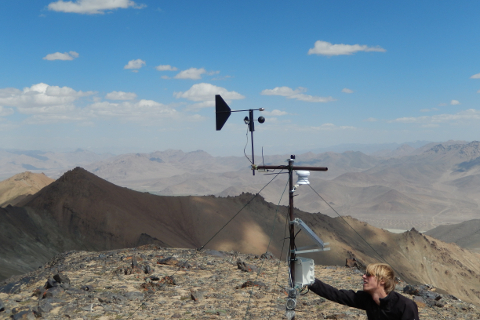
Transformation Processes in the Eastern Pamirs of Tajikistan. The presence and future of energy resources in the framework of sustainable development (2012-2015), funded by VolkswagenFoundation
The joint research effort on transformation processes in the Eastern Pamirs has focused on the supply and use of local energy resources. The setup of the project team enabled us to emphasize the nexus of geo-ecological preconditions for dwarf shrubs as an energetic source and the patterns of human utilization of this resource. Additionally, the potential of wind and solar energy was evaluated. The results of the energy system model show that in terms of environmentally sustainable considerations dwarf shrubs can provide a relevant share of the energy mix of settlements in the Eastern Pamirs. Solar energy could also be a substantial part of the energy mix. Furthermore, the study has pointed out an optimization potential in the described energy system and could be used for policy testing. ...more
- 2010-2014: Project in Mali and SenegalHide
-
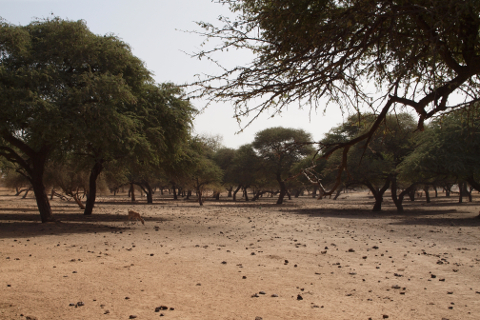
Climate Change, Environmental Changes and Migration - Social-Ecological Conditions of Population Movements: The Example of the Sahelian Countries Mali and Senegal (2010-2014), funded by BMBF
The interdisciplinary research project MICLE focused on the linkages between environmental change and migration in Mali and Senegal. Politicians and scientists increasingly emphasize environmental change as one of the major threats to sustainable human livelihoods in Africa and predict massive population movements as a response to a growing number of extreme events such as droughts, increasing water scarcity, a detrimental decrease of food production, changing disease patterns and loss of biodiversity. In the two study regions we were able to show that a complex pattern of environmental change is mainly related to human activities and only partly to climate variability. After the long droughts in the 70s and 80s the precipitation increased but did not reach the pre-drought amounts. Despite the precipitation situation, close to settlements a greening is observed caused by agroforestry activities and reforestation. Hence, the greening is mainly caused by woody species. While the number of woody plants is increasing a decline of biodiversity is observed with a shift towards species tolerant against drought and browsing. Further away from settlements degradation is happening caused by heavy grazing and firewood extraction. As these processes are taking place close by differences in precipitation play a subordinate role. The results of the sub-project also show that management strategies can mitigate …more
- 2007-2011: Project in the Eastern Pamirs of TajikistanHide
-
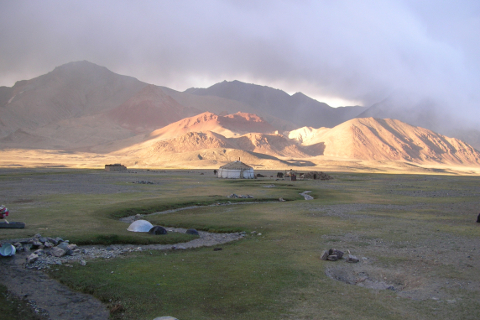
Transformation Processes in the Eastern Pamirs of Tajikistan. Changing Land Use Practices, Possible Ecological Degradation and Sustainable Development (2007-2011), funded by VolkswagenFoundation
The research on transformation processes in the Eastern Pamirs has focused on the pastoral sector. The set-up of the project team enabled us to emphasize upon the nexus of geo-ecological properties and human utilization of pastoral resources. Thus, changes in space and time could be addressed in an empirical manner where test sites were congruent for both groups. The significant environmental and socio-economic changes during the 20th century are strongly linked to socio-political changes that can be termed as two transformations. The human-geographical and geo-ecological fieldwork generated substantial material supporting in-depth insight into the complex system of pastoral practices at the upper limits of habitation, the systemic properties and the triggering factors for change. Based on extensive field work, including sampling of the species composition, quantification of biomass and fodder values the pasture potential is now well known in a scale suitable for management purposes. The human-geographical results are based on interviews and ethnographic studies and revealed pasture management strategies The combination of the results show that under the existing geo-ecological conditions and with current livestock numbers, the pasture potential at large is sufficient if the whole region is used. But, in more detail competition between pastoralists has led to significant under- and overgrazing caused by a mismatch of formal user rights and grazing practices. Theory and practice are quite distinct. Conflict is prone in such situations and constraining the sustainable use of natural resources. The modification of grazing patterns could be identified as caused by legal pluralism and varying mechanisms to execute power and pressure. Farmers Associations as the “official” and only holders of land titles are challenged. Influential and wealthy herders claim customary and inherited user rights. Conflicting interests challenge the authority of these organizations. Farmers Associations need to enforce their rights and to reallocate pasture rights balancing the demand and according to ecological requirements on the base of applicable knowledge generated by our research. If they succeed, the majority of the livestock breeders will get access to productive pastures and have a chance to improve their herd productivity. …more
- 2003-2005: Project in northwestern Namibia Hide
-
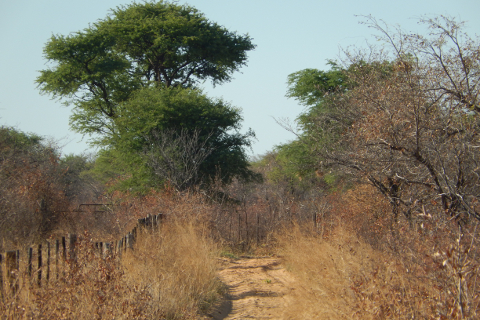
Analysis of vegetation changes with NOAA-AVHRR and MODIS data to detect degradation in northwestern Namibia (2003-2005), funded by DFG
A previous project focusing on Etosha National Park and other projects show the correlation of seasonal variations of the Normalized Difference Vegetation Index (NDVI) derived from multi-temporal satellite data and from the seasonal distribution of rainfall. The results from the project in Etosha also demonstrated that standard methods could fail under certain environmental conditions. Along a transect from the east of Etosha towards the Skeleton National Park in the West of Namibia six woody cover classes were derived from Landsat 7 images based on extensive field work. This was the basis for the validation of results derived from coarse AVHRR data. Instead of the Fourier Transformation a model using the seasonal curves of the NDVI of the six woody classes was developed. Using this model it was possible to classify woody classes for northern Namibia and to quantify changes in woody coverage. …more
- 2002-2002: Project in Etosha National Park in NamibiaHide
-
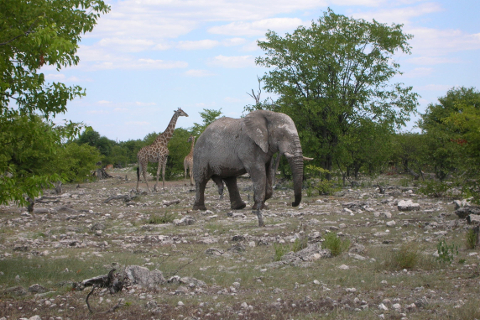
Analysis of bush encroachment with NOAA-AVHRR-data in Etosha National Park (Namibia) (2002-2002), funded by DFG
Bush encroachment is explained by overgrazing and fire suppression and also taking place in National Parks. For Etosha National Park the vegetation patters are well known and documented which enables to validate and explain changes analyzed by satellite data. A standard approach to explain different phenology of woody and herbaceous species was used, the Fourier Transformation. For two consecutive rainy seasons the vegetation was classified based on the Fourier Transformation of AVHHR time series. The comparison of the classes in the two years showed that the method ca not be used for Namibian savanna ecosystems, e.g. in the first year regions were classified as grassland and as woody savanna in the following year. A explanation could be the very heterogeneous rainfall patterns in semi-arid savanna ecosystems influencing the NDVI time series …more
- 1998-2001: Project in Southeastern ZimbabweHide
-
Determination of the Grazing Capacity in Southeastern Zimbabwe Using Satellite Images (1998-2001), partly funded by DFG
The forests in southern Africa are the largest dry forests worldwide. A permanent pressure of utilization by all countries sharing these forests leads to an increasing exploitation and degradation. The study area in Zimbabwe is an example representing a variety of land use forms as well as the climatic change within the Miombo forests. Livestock pasture is one of the dominant land use forms, carried out intensively especially in the areas of small scale farming. It is therefore a major determinant for the forest degradation. …more
